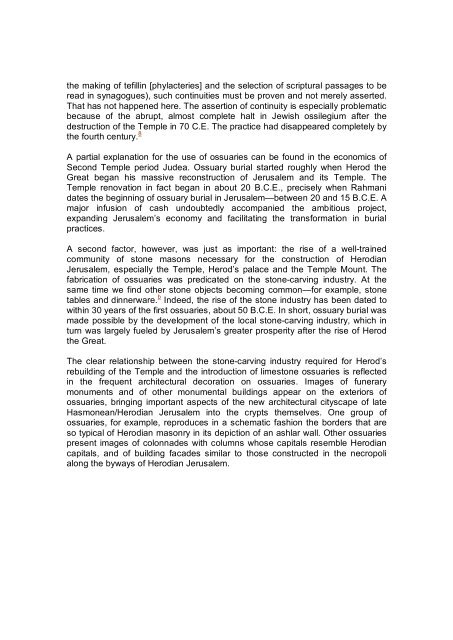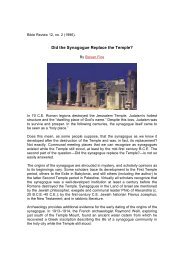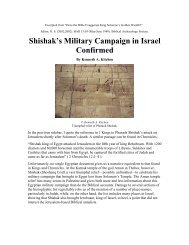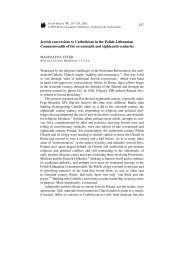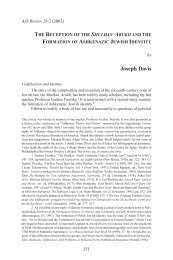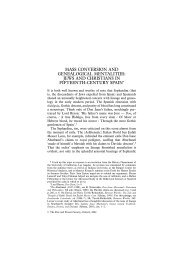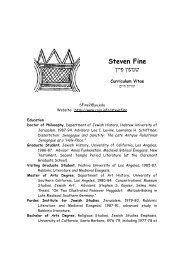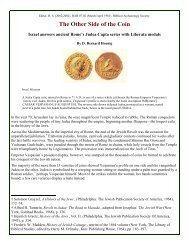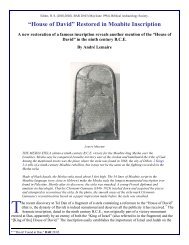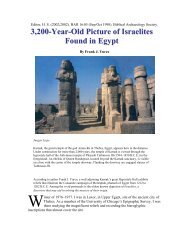Why Bone Boxes? Splendor of Herodian Jerusalem reflected in ...
Why Bone Boxes? Splendor of Herodian Jerusalem reflected in ...
Why Bone Boxes? Splendor of Herodian Jerusalem reflected in ...
You also want an ePaper? Increase the reach of your titles
YUMPU automatically turns print PDFs into web optimized ePapers that Google loves.
the mak<strong>in</strong>g <strong>of</strong> tefill<strong>in</strong> [phylacteries] and the selection <strong>of</strong> scriptural passages to be<br />
read <strong>in</strong> synagogues), such cont<strong>in</strong>uities must be proven and not merely asserted.<br />
That has not happened here. The assertion <strong>of</strong> cont<strong>in</strong>uity is especially problematic<br />
because <strong>of</strong> the abrupt, almost complete halt <strong>in</strong> Jewish ossilegium after the<br />
destruction <strong>of</strong> the Temple <strong>in</strong> 70 C.E. The practice had disappeared completely by<br />
the fourth century. 8<br />
A partial explanation for the use <strong>of</strong> ossuaries can be found <strong>in</strong> the economics <strong>of</strong><br />
Second Temple period Judea. Ossuary burial started roughly when Herod the<br />
Great began his massive reconstruction <strong>of</strong> <strong>Jerusalem</strong> and its Temple. The<br />
Temple renovation <strong>in</strong> fact began <strong>in</strong> about 20 B.C.E., precisely when Rahmani<br />
dates the beg<strong>in</strong>n<strong>in</strong>g <strong>of</strong> ossuary burial <strong>in</strong> <strong>Jerusalem</strong>—between 20 and 15 B.C.E. A<br />
major <strong>in</strong>fusion <strong>of</strong> cash undoubtedly accompanied the ambitious project,<br />
expand<strong>in</strong>g <strong>Jerusalem</strong>’s economy and facilitat<strong>in</strong>g the transformation <strong>in</strong> burial<br />
practices.<br />
A second factor, however, was just as important: the rise <strong>of</strong> a welltra<strong>in</strong>ed<br />
community <strong>of</strong> stone masons necessary for the construction <strong>of</strong> <strong>Herodian</strong><br />
<strong>Jerusalem</strong>, especially the Temple, Herod’s palace and the Temple Mount. The<br />
fabrication <strong>of</strong> ossuaries was predicated on the stonecarv<strong>in</strong>g <strong>in</strong>dustry. At the<br />
same time we f<strong>in</strong>d other stone objects becom<strong>in</strong>g common—for example, stone<br />
tables and d<strong>in</strong>nerware. b Indeed, the rise <strong>of</strong> the stone <strong>in</strong>dustry has been dated to<br />
with<strong>in</strong> 30 years <strong>of</strong> the first ossuaries, about 50 B.C.E. In short, ossuary burial was<br />
made possible by the development <strong>of</strong> the local stonecarv<strong>in</strong>g <strong>in</strong>dustry, which <strong>in</strong><br />
turn was largely fueled by <strong>Jerusalem</strong>’s greater prosperity after the rise <strong>of</strong> Herod<br />
the Great.<br />
The clear relationship between the stonecarv<strong>in</strong>g <strong>in</strong>dustry required for Herod’s<br />
rebuild<strong>in</strong>g <strong>of</strong> the Temple and the <strong>in</strong>troduction <strong>of</strong> limestone ossuaries is <strong>reflected</strong><br />
<strong>in</strong> the frequent architectural decoration on ossuaries. Images <strong>of</strong> funerary<br />
monuments and <strong>of</strong> other monumental build<strong>in</strong>gs appear on the exteriors <strong>of</strong><br />
ossuaries, br<strong>in</strong>g<strong>in</strong>g important aspects <strong>of</strong> the new architectural cityscape <strong>of</strong> late<br />
Hasmonean/<strong>Herodian</strong> <strong>Jerusalem</strong> <strong>in</strong>to the crypts themselves. One group <strong>of</strong><br />
ossuaries, for example, reproduces <strong>in</strong> a schematic fashion the borders that are<br />
so typical <strong>of</strong> <strong>Herodian</strong> masonry <strong>in</strong> its depiction <strong>of</strong> an ashlar wall. Other ossuaries<br />
present images <strong>of</strong> colonnades with columns whose capitals resemble <strong>Herodian</strong><br />
capitals, and <strong>of</strong> build<strong>in</strong>g facades similar to those constructed <strong>in</strong> the necropoli<br />
along the byways <strong>of</strong> <strong>Herodian</strong> <strong>Jerusalem</strong>.


